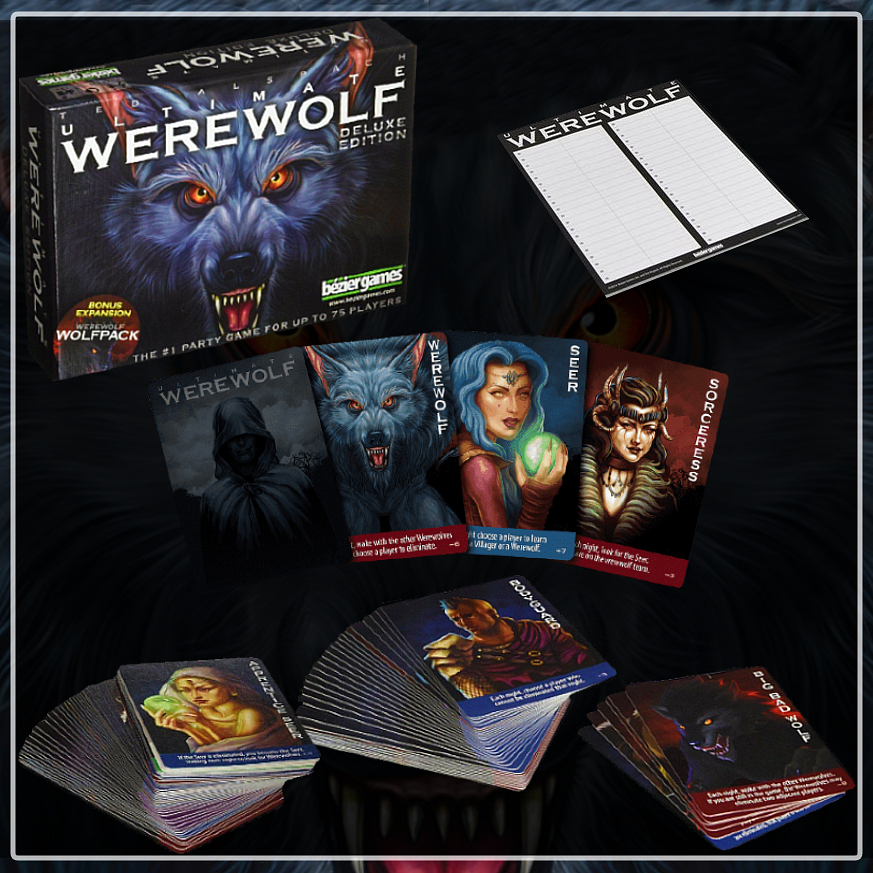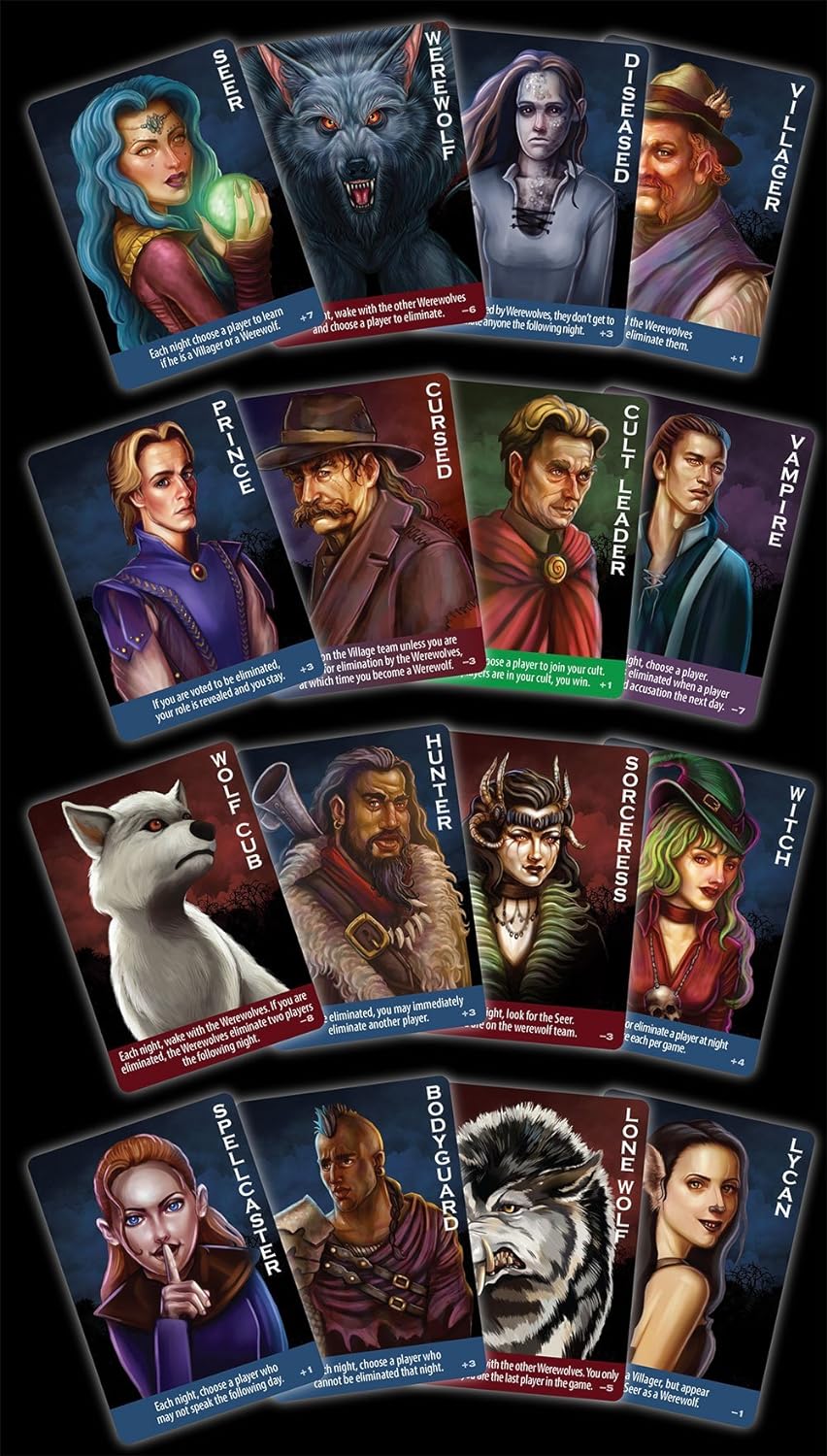Ultimate Werewolf is a party game that transforms your friendly gathering into a chaotic werewolf-hunting frenzy. In this game of deduction and deception, players take on roles like villagers, seers, and, of course, sneaky werewolves.
Imagine your friends and family attempting to convince you that they’re not the hairy, moonlight-loving culprits, while their alibis become wilder than a werewolf’s howl on a full moon night.
As the game unfolds, expect arguments that rival courtroom dramas, with players desperately defending their innocence and accusing others of lycanthropic tendencies.
Whether you’re accusing Aunt Mildred of moonlight transformations or defending yourself with more conviction than a Hollywood star, Ultimate Werewolf is a howling good times.
What’s included in Ultimate Werewolf

- Game Moderator: One player serves as the moderator who knows the roles of all the players but does not participate in the game.
- Role Cards: Role cards are assigned to each player. These include cards for villagers, werewolves, and special roles like the Seer, the Doctor, etc.
- Voting Tokens: Players may receive voting tokens to cast their votes.
- Timer: A timer or clock is used to time the discussion rounds.
How to play Ultimate Werewolf
Ultimate Werewolf is a social deduction party game that pits players against one another in a battle of wits. In this game, some players take on the role of werewolves, while others are villagers. The objective of the villagers is to identify and eliminate the werewolves, while the werewolves aim to avoid detection and eliminate the villagers. Here’s how to play:
Setup
- Assign Roles: The moderator secretly assigns roles to each player. For example, you may have a few villagers, a few werewolves, and some special role cards.
- Sit in a Circle: Players sit in a circle, and the game begins with a “night” phase where everyone closes their eyes.
Rules for Ultimate Werewolf
Ultimate Werewolf is played over several rounds, with each round having two phases: Night and Day.
Night Phase:
- During the night, all players close their eyes. The moderator then calls upon the werewolves to open their eyes and silently agree on one player to eliminate. The moderator will acknowledge their choice.
- The moderator may also call upon any special roles like the Seer or Doctor to use their abilities, which can include identifying a player’s role or protecting a player from elimination.
- After all night actions are resolved, the moderator announces that it is morning, and everyone opens their eyes.
Day Phase:
- In the morning, players discuss who they believe the werewolves are. This phase is where the game’s deduction and bluffing elements come into play.
- Players can make accusations, defend themselves, and try to persuade others of their innocence. The goal is for the villagers to identify and vote to eliminate the suspected werewolves.
- When players are ready to vote, they use their voting tokens to cast their votes. The player with the most votes is eliminated from the game.
- The eliminated player reveals their role card to confirm if they were a villager or a werewolf.
Winning the Game: The game continues with alternating night and day phases until one of the following conditions is met:
- The villagers successfully eliminate all the werewolves, in which case they win.
- The werewolves equal or outnumber the remaining villagers, in which case the werewolves win.
Additional Rules:
- Special role cards may have unique abilities that impact the game. Players should be familiar with the abilities of their assigned roles.
- Some versions of the game include additional roles and variations, adding complexity and fun twists to the gameplay.
Roles in Ultimate Werewolf

There are two key classes of roles that players should be aware of – basic roles and advanced roles. The following list all possible roles that you’ll encounter during a quick game of Ultimate Werewolf.
Basic Roles
- Werewolves: These are the main antagonists of the game, trying to eliminate villagers without getting caught. There can be multiple werewolves.
- Villagers: These are the innocent townsfolk trying to identify and eliminate the werewolves.
- Seer: The Seer has the ability to secretly identify another player’s role during the night.
- Doctor: The Doctor can protect one player each night from being eliminated by the werewolves.
Advanced Roles:
- Alpha Wolf: This werewolf role has a special ability, such as turning another player into a werewolf or gaining additional knowledge.
- Cursed: A player who is cursed starts as a villager but becomes a werewolf if they are eliminated.
- Mystic Wolf: Similar to the Seer, the Mystic Wolf can identify other players’ roles, but they are also a werewolf.
- Bodyguard: The Bodyguard can protect one player from elimination each night, just like the Doctor.
- Tanner: The Tanner’s goal is to get themselves eliminated by convincing others that they are a werewolf. If they succeed, they win.
- Cult Leader: The Cult Leader tries to recruit other players into their cult. If the Cult Leader and their cult members survive, they win together.
- Minion: Minions are werewolves who are aware of each other’s identities but not the identities of other werewolves. Their goal is to protect the werewolves.
- Hunter: When the Hunter is eliminated, they get to eliminate another player of their choice as a parting shot.
- Witch: The Witch has special abilities, such as healing a player or eliminating a player each night.
- Robber: The Robber can exchange roles with another player, potentially becoming a werewolf.
- Troublemaker: The Troublemaker can swap the roles of two other players without knowing the roles they are swapping.
- Insomniac: The Insomniac checks their own role card at the end of the night to see if it has changed.
- Doppelgänger: The Doppelgänger takes on the role of another player at the beginning of the game.
- Dream Wolf: This werewolf role appears to be a villager when checked by the Seer.
- Cupid: Cupid pairs two players, and if one is eliminated, the other is eliminated as well.
- Village Idiot: The Village Idiot must vote for a player to be eliminated every day.
- Sorcerer: The Sorcerer learns the roles of two players in the middle of the night but doesn’t know which is which.
- Lycan: The Lycan appears as a werewolf to the Seer but isn’t actually a werewolf.
- Aura Seer: The Aura Seer can detect the alignment (villager or werewolf) of another player.
- Beholder: The Beholder learns the identity of the Seer during the night.
- Diseased: If the Diseased player is eliminated, the player who eliminated them becomes Diseased.
Gameplay strategies
Ultimate Werewolf is a game of deception, deduction, and social interaction. Here are some strategies that players can employ to excel in the game, whether they’re villagers trying to identify the werewolves or werewolves trying to avoid detection:
For Villagers
- Observe Behavior: Pay close attention to how players behave during discussions. Werewolves may exhibit nervousness, inconsistencies, or overly defensive behavior.
- Form Alliances: Build alliances with other players to collectively identify the werewolves. Share information and suspicions with trusted players.
- Use Special Roles Wisely: If you have a special role like the Seer or Doctor, use your abilities strategically. Don’t reveal your role too early; doing so could make you a target for elimination.
- Ask Questions: Question players about their actions and decisions. Ask the Seer if they’ve identified any werewolves, and ask the Doctor if they’ve protected anyone.
- Consistent Voting: Be consistent in your voting patterns. If you suspect someone is a werewolf, vote to eliminate them. Inconsistent voting may raise suspicion.
For Werewolves
- Blend In: Act like a villager. Avoid suspicious behavior like aggressively accusing others or trying too hard to appear innocent.
- Spread Suspicion: Point fingers at other players, even your fellow werewolves, to create confusion and sow discord among the villagers.
- Claim Villager Roles: If you’re questioned about your role, claim to be a villager with a specific occupation. Make sure your claim is consistent with the roles in the game.
- Use Special Roles to Your Advantage: If you have special roles like the Seer or Doctor among the werewolves, coordinate your actions to deceive the villagers. For example, the Seer can falsely identify innocent players as werewolves.
- Vote Strategically: When voting to eliminate players, consider the potential consequences. Sometimes it’s better for the werewolves to let a suspicious player live and create confusion rather than eliminate them.
General Tips
- Maintain a Poker Face: Whether you’re a villager or a werewolf, try to maintain a neutral expression and tone during discussions. Revealing your emotions can give away valuable information.
- Create Doubt: As a villager or werewolf, your goal is to create doubt and uncertainty among other players. Question the logic of their arguments and cast doubt on their accusations.
- Adapt to the Group: “Ultimate Werewolf” can be played in various settings, and player dynamics can differ. Adapt your strategy to the group’s playing style.
- Bluff and Mislead: Use misdirection and bluffing to confuse your opponents. It’s not just about the information you provide but also the information you withhold.
- Time Management: Manage the time allotted for discussions. Prolonged debates can lead to indecision, and the werewolves may benefit from confusion.
Ultimately, pun intended, the key to success in Ultimate Werewolf is the ability to read others, make convincing arguments, and think on your feet. Whether you’re a villager trying to uncover the werewolves or a werewolf attempting to avoid detection, the game’s social dynamics and strategies make it a thrilling and unpredictable experience.